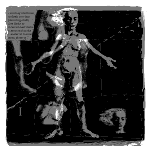Getting All Hyper
 At Salon, Paul LaFarge discusses the fate of hypertext fiction, celebrated as the coming new thing in the 1990s and forgotten today.
At Salon, Paul LaFarge discusses the fate of hypertext fiction, celebrated as the coming new thing in the 1990s and forgotten today.
Born into a world that wasn’t quite ready for it, and encumbered with lousy technology and user-hostile interface design, it got a bad reputation, at least outside of specialized reading circles. At the same time, it’s impossibly hard to create, one of the only modes of fiction I know of which is more demanding than the novel. (And then add to that the need to create a user interface, and maybe a content-management system, and is it going to be an app? Suddenly your antidepressants aren’t nearly strong enough to get you out of bed.)LaFarge name-checks several print precursors to digital hypertexts: Laurence Sterne’s Tristram Shandy (1759-69), Vladimir Nabokov’s Pale Fire (1962), Júlio Cortázar’s Hopscotch (1963), and Jacques Roubaud’s The Great Fire of London (1989).
It’s tempting to leave the story there, and to let the hypernovel, or whatever you want to call it, become part of the technological imagination of the past, like the flying car. But I believe that the promise of hypertext fiction is worth pursuing, even now, or maybe especially now. On the one hand, e-books are beginning to offer writers technical possibilities that, being human, we’re going to be unable to resist. On the other, the form fits with life now. So much of what we do is hyperlinked and mediated by screens that it feels important to find a way to reflect on that condition, and fiction, literature, has long afforded us the possibility of reflection.
Just as the novel taught us how to be individuals, 300 years ago, by giving us a space in which to be alone, but not too alone — a space in which to be alone with a book — so hypertext fiction may let us try on new, non-linear identities, without dissolving us entirely into the web.
He also identifies Shelley Jackson’s “Patchwork Girl” and Geoff Ryman’s “253” as the possible “first classics of the genre, both for the quality of their prose and because they found ways to make their fragmentary forms feel purposeful.”
Jackson took the title and some inspiration for her hypertext work from The Patchwork Girl of Oz, of course. Ryman is the author of Was, a fictional study of L. Frank Baum, Judy Garland, and the Oz phenomenon in American culture. I’m just saying.


No comments:
Post a Comment